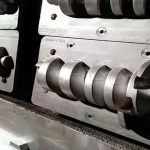Three-dimensional design
The design process of 3D printing is to first model by computer-aided design (CAD) or computer animation modeling software, and then “divide” the built three-dimensional model into layer-by-layer sections, thereby instructing the printer to print layer by layer.
The standard file format for collaboration between the design software and the printer is the STL file format. An STL file uses triangular faces to roughly simulate the surface of an object. The smaller the triangle, the higher the resolution of the resulting surface. PLY is a scanner that generates three-dimensional files by scanning. The VRML or WRL files it generates are often used as input files for full-color printing.
Printing process
The printer reads the cross-sectional information in the file, prints these cross-sections layer by layer with liquid, powder or sheet-like materials, and then glues the cross-sections of each layer in various ways to create an entity. The characteristic of this technology is that it can make almost any shape of objects.
The thickness of the cross-section printed by the printer (ie the Z direction) and the resolution in the plane direction that is the X-Y direction are calculated in dpi (pixels per inch) or micrometers. The general thickness is 100 microns, or 0.1 mm, and some printers such as the Objet Connex series and 3D Systems’ ProJet series can print a thin layer of 16 microns. The plane direction can print out the resolution similar to that of a laser printer. The diameter of the printed “ink drop” is usually 50 to 100 microns. It usually takes several hours to several days to manufacture a model using traditional methods, depending on the size and complexity of the model. The use of 3D printing technology can shorten the time to several hours, of course, it is determined by the performance of the printer and the size and complexity of the model.
Traditional manufacturing technologies such as injection molding can produce polymer products in large quantities at a lower cost, while 3D printing technology can produce relatively small numbers of products in a faster, more flexible, and lower-cost way. A desktop-sized 3D printer can meet the needs of designers or concept development teams to make models.
Complete
The current resolution of 3D printers is sufficient for most applications (it may be rough on curved surfaces, like jagged images). To obtain higher resolution items, you can use the following method: first use the current 3D The printer prints out a slightly larger object, and then slightly polishes the surface to get a smooth “high-resolution” object.
Some technologies can use multiple materials for printing at the same time. Some technologies also use supports in the printing process. For example, when printing some upside-down objects, you need to use something that is easy to remove (such as soluble things) as a support.
Link to this article:The Principle Of 3D Printing
Reprint Statement: If there are no special instructions, all articles on this site are original. Please indicate the source for reprinting:Mold Wiki,Thanks!^^

